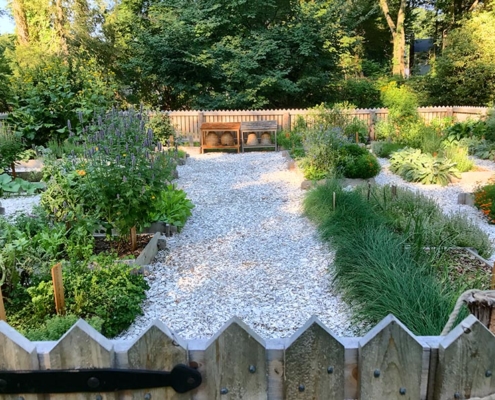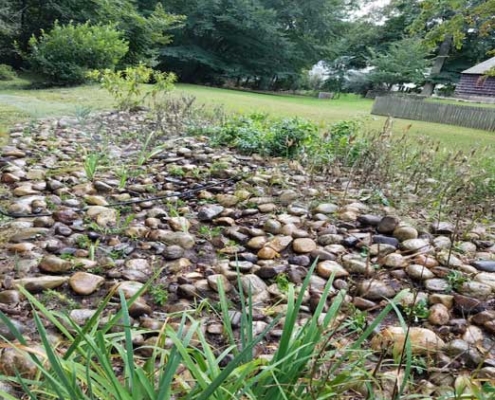The 1750 Ogden House
The Colonial Dooryard Garden, Apiary, and Riparian Border
Since 1935, The Fairfield Garden Club has collaborated with the owners of the grounds of the saltbox homestead built in 1750 for Jane and David Ogden. This once seventy-five-acre sprawling farm off Bronson Road now only has two acres. The remaining land is bisected by Browns Brook. The original house is listed in the National Register of Historic Places.
Our first chapter of stewardship was by our Civic Committee in the 1930s. They created plans and planting at Ogden House in 1934-1935 “such as might have been there in the old days”, as The Fairfield Garden Club’s contribution to the Tercentenary Celebration of the State of Connecticut. The owner of Ogden House was a member of the Club, Mary Allis, a renowned antique dealer who bought the property in 1931 from Annie Burr Jennings. Her interest in a slope-side herb garden near the house and wildflowers matched the Committee’s interest in establishing a period garden. After selling the property, Miss Allis remained as a tenant to 1974.
The Fairfield Museum and History Center (then known as the Fairfield Historical Society) took over ownership of the property in 1974. The role of the Club evolved and grew. The Club responded with the creation of wildflower gardens in the woods, adding a pedestrian bridge over the watercourse and creating and maintaining borders of plants close to the house for forty years. Using design principles of the renowned historic landscape designer Anne Leighton, a new colonial kitchen garden was created as an educational resource to the Museum.
Starting in 2009, the Club again greatly expanded its role. The property had been overwhelmed with overgrown trees, shrubs and invasives. The Club undertook a massive cleanup and added new features.
In 2013, an apiary was added in the adjacent brookside land of Oak Lawn Cemetery. The funds from sales at the Museum from the honey harvested from those hives supports myriad learning opportunities for schoolchildren about beekeeping in the colonies. The colonists had brought European honey bees to the new world. These vital bee hives are major pollinators in a five-mile radius from the property.
In 2014, the Club for its own Centennial Conservation Education project took a swath of sandy soil, a linear garden seventy feet long by eight feet wide adjacent to the brook and created a riparian border pollinators’ garden. Using over one hundred and fifty native perennials selected to meet the criteria of occasional inundations and deer resistance, the plants serve to act as a filter to add oxygen to the stream’s water for the flash floods of Browns Brook. The border provides an easy to follow model of how to enhance the edge of a stream, using the existing soil, accepting seasonal inundation, avoiding pesticides, herbicides and fertilizers, and planting for successive plant bloom. In the most recent 85-year flood in 2018, the buffer held up, and Browns Brook reshaped its edges to the watercourse. It won the The Garden Club of America Marion Thompson Fuller Brown Conservation Education Award in 2015.
From 2015-2017, the colonial garden was relocated and enlarged. It was fenced in a more historically sympathetic way, re-tooled and renamed to become a “dooryard garden.” This consists of colonial period plants Jane Ogden would likely have used for illness, for first aid, for culinary use, for household air quality and for celebrations. Raised rectangular beds make the most of the space and allow the soil to dry out quickly in early spring, providing a longer growing season. The paths between the raised beds are made of oyster shells. In 2018, the Club added another educational resource: detailed signs for each plant and data on its range of practical uses in Jane Ogden’s time. The signs also highlight the many plants from the Native Americans that Jane Ogden learned to use as well.
For over eight decades, The Fairfield Garden Club has continued to monitor, design, plant, revise, enrich and transform this colonial homestead for school children’s education and the larger community about our watershed. It is an authentic window into our functional farming history. The Club’s stewardship highlights the pivotal role of pollinators and celebrates how one family survived and thrived using and fully understanding their land’s bounty and assets. To this day, every member of The Fairfield Garden Club volunteers time to work on this site.




















